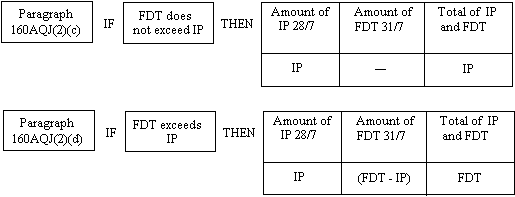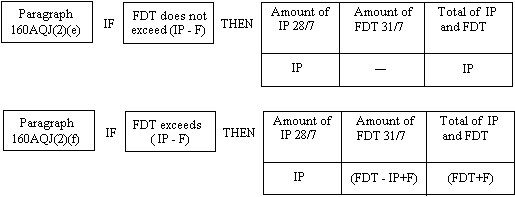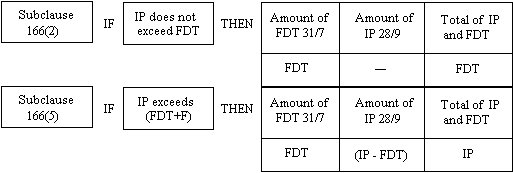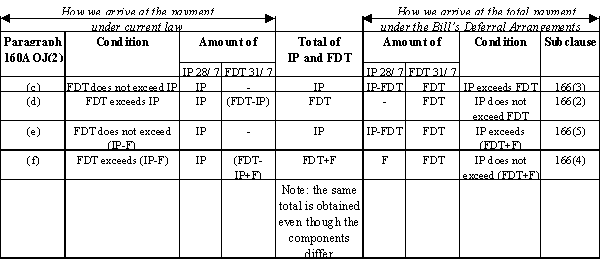Explanatory Memorandum
(Circulated by the authority of the Treasurerthe Hon John Dawkins, M.P.)This Memorandum takes account of amendments made by the House of Representatives to the Bill as introduced.Chapter 17 DEFERRAL OF INITIAL PAYMENTS OF COMPANY TAX FOR 1993-94
Overview
The Bill will defer the time for the initial payment of company tax for the 1993-94 income year.
Summary of amendments
17.1 Purpose of amendments : To defer the time for the initial payment of income tax (IP) for the 1993-94 income year by companies, superannuation funds, approved deposit funds and pooled superannuation trusts (all referred to as companies).
17.2 The measure to defer the IP, which was announced in the 1993 Budget, is similar to the deferral for the 1990-91 and 1991-92 income years. The purpose of the deferral arrangements is to provide relief for small companies by extending the due date for the IP.
17.3 The two main differences to the earlier deferrals are that the deferral of IP for the 1993-94 year of income -
- •
- will affect companies which have a notional or estimated tax liability of more than $1,000 and less than $300,000; and
- •
- will apply to all companies regardless of their balancing dates.
17.4 The date for the IP will be deferred for 2 months to the 28th day of the third month following balance date.
17.5 Date of effect : The amendments will commence from the date the Bill receives Royal Assent and will apply to defer the IP for companies (including early balancers) for the 1993-94 year of income.
Background to the legislation
17.6 For the 1993-94 year of income, companies are required to pay their income tax under one of the following methods, depending on their level of tax liability:
| Tax Liability | Method of Payment for June Balancers |
|---|---|
| $20 000 or more | 2 Payments: IP on 28 July final payment on 15 March |
| $1 000 or more but less than $20 000 | 2 payments: IP on 28 July final payment on 15 March OR 1 payment: on 15 December |
| Less than $1 000 or no notional tax | 1 payment: on 15 March |
Companies with a tax liability of $20,000 or more
17.7 Companies with a notional tax liability of $20,000 or more (which do not estimate their liability on income of the relevant year to be less than $20,000) are required to make two payments of tax each year. For a company balancing in June, the IP is due on 28 July following balance date [section 221AP of the Income Tax Assessment Act 1936 (the Act)]. The IP (sections 221AD, 221AQ and 221AP) is:
- •
- 85% of the notional tax (i.e. the tax payable at the current year rate on the taxable income of the preceding income year ); or
- •
- 85% of the tax which the company estimates will be payable on its taxable income for the income year.
17.8 The balance of the company's total actual tax liability is due on 15 March following the balance date (section 221AZD). If the IP made by a company exceeds the total actual tax liability, the company will receive a refund from the Commissioner unless a debt exists under another taxation law (section 221AZF).
Companies with a tax liability of $1,000 or more but less than $20,000
17.9 Companies with a notional tax liability of $1,000 or more but less than $20,000, or a notional tax liability of $20,000 or more but which estimate their tax liability for the income year to be in the range $1,000 to $20,000, have two payment options. They may pay in the same way as companies whose tax liability is $20,000 or more (see above notes); or alternatively, they may elect to make a single payment of the total actual tax liability for the income year on 15 December following balance date (section 221AU).
Companies with a tax liability of less than $1,000
17.10 Companies with a tax liability of less than $1,000 are required to make a single payment of their total actual liability for the income year on 15 March following balance date (section 221AT).
Companies with substituted accounting periods
17.11 As explained above, the possible payment dates are 28 July, 15 December and 15 March for companies whose balance date is 30 June. For companies with substituted accounting periods ending on or before 31 May in lieu of the following 30 June, the corresponding payment dates are the 28th day of the first month and the 15th day of the sixth and ninth months following balance date (subject to 28 January being the earliest required payment date). For late balancing companies the corresponding payment dates are within the same timeframe as for early balancing companies, except that the final payment is due no later than 15 June in the year following the year of income (section 221AN).
Franking account credits and debits for initial payment of tax
17.12 When a company makes an IP, a franking credit for the adjusted amount of that IP arises on the day it makes its IP (section 160APMA). Further, a franking debit arises where a refund of tax which gave rise to a franking credit, is made (section 160APYBA).
17.13 Special credits and debits arise to life assurance companies to exclude from the franking account, debits and credits in respect of statutory fund income allocated to participating policy holders (sections 160APVBA, 160APVH, 160AQCD and 160AQCN), [ sections 160APVH and 160AQCN are to be inserted by Clauses 59 and 78] .
The Existing Law for Franking Deficit Tax (FDT)
17.14 A company which pays franked dividends in excess of its franking credits in a given year may be liable to pay an amount of FDT. This is essentially a payment required to make good the amount imputed to shareholders which exceeds the amount available to be imputed. The amount of FDT to be paid is calculated based on the amount of the franking deficit and the company tax rate (subsection 160AQJ(1)).
17.15 FDT must be paid on the last day of the month following balance date. For companies balancing in June, payment of FDT is due on 31 July (section 160ARU). This date is three days later than the due date for the IP (see above).

17.16 The payment of FDT may be reduced or made unnecessary by the IP (if any) payable by a company where that IP is based on an estimate made by the company. Accordingly, where the FDT due does not exceed the IP, no FDT is payable by the company. Where the FDT due exceeds the IP, the company need only pay the excess (subsection 160AQJ(2)).

17.17 The reduced amount of FDT required to be paid by life assurance companies as a result of the IP differs from that payable by other companies. The FDT amount payable by life assurance companies is calculated by reference to the eligible fund component (F) of the company (subsection 160AQJ(2)). The eligible fund component is that part of the taxable income that is subject to concessional tax treatment under Division 8 of Part III of the Act (Life Assurance Companies). It excludes the non-fund component which covers income relating to assets which are not included in an insurance fund maintained by the company; that is, income derived from business other than life assurance, superannuation and accident and disability business.
Current franking account debits for reduced FDT
17.18 If the FDT due does not exceed the IP, a franking debit equal to the adjusted amount of the FDT arises (paragraph 160APYC(a)). If the FDT due exceeds the IP, a franking debit equal to the adjusted amount of the IP arises (paragraph 160APYC(b)).
Deferral arrangements will affect FDT payments
17.19 The due date for payment of FDT will not change as a result of Part 12 of the Bill. However, payments of FDT will affect the amount of the IP otherwise due.
Explanation of the amendments
Nine week deferral of IP for 1993-94 income year
7.20 The Bill will modify the operation of the the Act by deferring the time for the affected companies to pay the IP from the 28th day of the month after balance date to the 28th day of the third month after balance date. For companies which balance on 30 June 1994, this means the due date for the IP will be deferred from 28 July to 28 September 1994 [Clause 165] .
17.21 As mentioned above, a company's FDT is due on the last day of the month following balance date. For companies balancing in June 1994, payment of FDT is required on 31 July 1994.
17.22 Therefore, under the deferral arrangements, FDT will be paid before the IP, rather than after the IP as would normally be the case. Accordingly, the Bill provides for the IP for companies estimating their tax payable to be reduced or made unnecessary by any prior payment of FDT. This ensures that the same total of FDT and IP is paid under both the existing arrangements and the deferral arrangements.
17.23 This reduction of the IP will not in any way affect the calculation of FDT due or franking credits and debits to be made in the franking account.
When will the FDT reduce the IP?
17.24 The IP will be reduced or made unnecessary where a company:
- •
- makes an estimate of its tax due for the purposes of determining the amount of its IP; and
- •
- is liable, under the deferral arrangements, to make an IP not later than the 28th day of the third month following balance date; and
- •
- will pay FDT before giving a notice estimating its taxable income for 1993-94 [Subclause 166(1)] .

17.25 Where the IP due does not exceed the FDT paid, a company will not be required to make the IP [Subclause 166(2)] .
17.26 Consider a company which will balance in June 1994 and pay $30,000 FDT on 31 July 1994. If the company's IP (due on 28 July) is $25,000, the FDT liability of $30,000 will be reduced to $5,000 under the existing rules. However, under the deferral arrangements, as $30,000 FDT will have already been paid on 31 July, no IP will be due on 28 September.

17.27 Where the IP due will exceed the FDT paid, a company will be required to pay the difference between the IP and the FDT only [Subclause 166(3)] .
17.28 Assume $30,000 FDT will be paid on 31 July 1994 as in Example 1 and the company's IP (due on 28 September 1994) is $50,000. Under the deferral arrangements, the IP will be offset by the FDT paid and reduced to $20,000. Under the existing arrangements, the company would have paid $50,000 in total (i.e. an IP on 28 July of $50,000, and no FDT on 31 July because of the existing offset rules).
Special offset arrangements apply for life assurance companies
17.29 As for the IP deferral for the 1990-91 and 1991-92 income years, special provisions are required to ensure that life assurance companies pay the same total amount of FDT and IP under the deferral arrangements as they would have under the existing arrangements.

17.30 Where the amount of the IP due does not exceed the FDT paid plus the eligible fund component [subsection 160AQJ(2) - see also paragraph (f) of Clause 85 ], the life assurance company is required to pay an amount equal to the fund component on the due date for the IP [Subclause 166(4)] .

17.31 Where the amount of the IP due exceeds the FDT paid plus the eligible fund component, the life assurance company will be required to pay the difference between the IP due and the FDT paid [Subclause 166(5)] .
A reduced amount of IP does not affect the calculation of certain thresholds
17.32 The amount of the IP is used to calculate the thresholds which determine whether a company (balancing in June) can:
- •
- pay its income tax in one payment on 15 March (i.e. where its tax liability is less than $1,000) (section 221AU); or
- •
- pay its tax :
- -
- in two payments, an IP on 28 July and a final payment on 15 March (i.e. where its tax liability is between $1,000 and $20,000); or
- -
- elect to make one payment on 15 December (section 221AT).
17.33 Any reduction or elimination of an IP by a prior payment of FDT as described above will not apply for the purposes of calculating these thresholds [Clause 167] .
Credits where the IP is Reduced by FDT
17.34 Under the existing rules, a company is given credit against any tax assessed for the full amount of an IP made by the company.
17.35 Where the IP made by a company will be reduced, either partly or fully, under the deferral arrangements by a payment of FDT, the company will be given credit against tax assessed as though no reduction had been made. This will ensure that companies are in no way disadvantaged by the deferral arrangements [Clause 168] .
17.36 Where an IP will be made unnecessary by a prior payment of FDT, the credit will arise when the company notifies the Commissioner of its estimated income tax liability (described as a "paragraph 221AQ(1)(a) notice" in the Bill) [Subclause 169(1)] .
17.37 Where an IP will be reduced by a prior payment of FDT, the credit will arise when the reduced IP is made [Subclause 169(2)] .
Franking Credits and Debits where FDT is Paid
17.38 As explained in the Background to the legislation section above, payments of IP and FDT give rise to credits and debits to a company's franking account. Franking account credits enable franked dividends to be paid to shareholders.
The IP is notionally increased for franking account and FDT purposes
17.39 The deferral arrangements are not intended to affect the amount of the franking account credits and debits that arise under sections 160APMA, 160 APVBA, 160APYBA, 160APYC, 160AQCD, 160APVH and 160AQCN. They are also not intended to affect the liability for FDT and the consequential offset allowable under section 160AQK.
17.40 To ensure this result, the Bill provides that, for these purposes, the amount of the IP will be taken to be the amount that would have been paid if the IP had been made before any FDT was due. For FDT purposes, this notional increase has a consequential affect on the FDT liability [Clauses 169 and 170] .
17.41 In the examples used above and assuming the deferred IP is made on 28 September 1994, the franking account will be credited on that day for the adjusted amounts for $25,000 (Example 1) and $50,000 (Example 2). The debits on that day will be the adjusted amounts for $25,000 (Example 1) and $30,000 (Example 2). These are the franking account credits and debits that would have been made under the existing arrangements when the IP was paid and the FDT was offset.
The notional increase in the IP does not affect liability for FDT
17.42 This notional increase in the IP will ensure the FDT and franking account credits and debits are not affected by the deferral. Accordingly, as explained above, a notional increase in the IP for franking account purposes will reduce the FDT otherwise payable [Clause 170] .
17.43 The Bill prevents a company from gaining a refund for the reduction in FDT [Clause 171]. If a company was able to gain a refund in these circumstances, it would pay less tax than under the existing arrangements.
17.44 For the same reason, the operation of the FDT reduction provision as a result of the deferral arrangements, will not give rise to a franking credit under section 160APQA, where an FDT offset entitlement under sections 160AQK or 160AQKA is reduced [ Clause 172 ] .
Changed timing for franking credits and debits
17.45 Franking credits and debits that arise because of an IP or payment of FDT arise when the company made its IP. Where, because of a prior payment of FDT, a company will not be required to make an IP, the credits and debits will arise when the company gives the Commissioner its estimate of tax due (i.e. its paragraph 221AQ(1)(a) notice) [Subclause 169(1)] .

